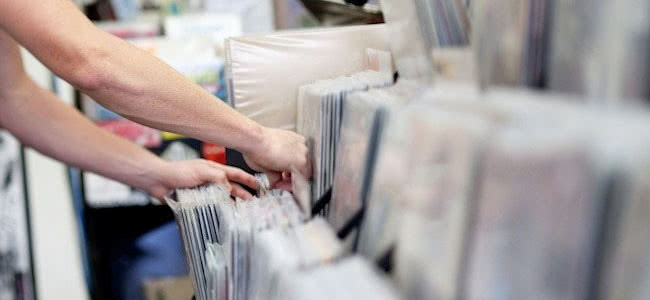As has already been demonstrated from overseas reports, vinyl is experiencing a major sales boom.
Over in the UK, the success of Record Store Day in April helped bring strong sales back to independent music retailers, while the US is currently experiencing its seventh consecutive year in growth.
Here in Australia, figures from ARIA show that while physical formats are dropping off sharply against the growing popularity of streaming services and digital downloads, vinyl is a format that remains a successful anomaly.
As ARIA indicates, Australia’s vinyl album sales increased by more than 70% in 2012 while single sales climbed by more than 50% on from 2011, as ABC News reports.
Meanwhile, ARIA CEO Dan Rosen has said that the doubling of vinyl sales in the last year has been “an interesting phenomenon… admittedly from a low base, but it went from approximately $1 million in sales to almost $2 million in sales in 12 months,” he says.
As for the renewed interest in the vintage format, Rosen remarks: “I think there’s a great romance about putting something on a turn table and dropping down the needle and hearing the little crackles and squeaks;” there is also a more practical element in “a lot of new artists are using vinyl as a way to give their fans a physical product and a lot of artists will give the vinyl but you’ll get a digital download as well when you buy the vinyl.”
As previously reported, it’s not just the older set of music fans that are helping the wax format blossom, but in fact a key purchasing demographic of 18-24 that are driving format sales. Something that Warwick Vere, the owner of the resuscitated Brisbane record store, Rocking Horse Records, has definitely noticed. “Vinyl went from approximately $1 million in sales to almost $2 million in sales in 12 months.”
– Dan Rosen, ARIA CEO
Love Music?
Get your daily dose of metal, rock, indie, pop, and everything else in between.
“We were lamenting the fact we had lost Gen Y. Lunchtime was a sea of lanyards and grey hair but vinyl has reinvigorated the Gen Ys coming in,” Vere tells ABC. He attributes the renaissance in vinyl as almost single-handedly rescuing his store from imminent closure in recent years; “towards the end of about 2009-10 there was a real vinyl resurgence. Which was just in time to save us.”
So why Gen Y’s interest in a format that had its dominant heyday before many of them were even born?
“There’s the perception that vinyl is a superior sound carrier,” explains Associate Professor Ian Woodward of Griffith University, who is releasing a book about the surge in vinyl interest next year. But that’s just one factor, and perhaps a minor concern. “It is, but of course not all listeners can tell much difference between a CD, digital or vinyl. But there is a widespread perception that vinyl sounds warmer and is more human.”
There is, of course, also the ‘cool’ factor. “To buy and listen to vinyl sometimes demonstrates a political commitment against the global download industry but is more often about demonstrating that one is a serious music listener,” adds Professor Woodward. “In this sense, vinyl is a material carrier of music heritage.”
In other words, a fascination and nostalgia with the little wax format that could, but its also about a growing appreciation for the artistic, physical artefact at a time when the music landscape is predominantly shifting to online and digital.
“They’re pieces of art, even just looking at the artwork on them,” enthuses Shannon Logan, a Brisbanite who opened her own store – Jet Black Cat Music – following the burgeoning success of her weekend market stall. “I’ll have them when I’m really, really old and I think that’s really nice. I can look back at my life and hand them down to my grandchildren,” she remarks of her treasured record collection. “Everyone of all ages is getting into vinyl and starting to collect and really appreciate that so it’s great.”
The demand for vinyl has also ensured a more steady supply, keeping Melbourne’s Zenith Records – Australia’s sole vinyl pressing plant – in business, and in fact doubling their work force and adding two new pressing machines to their facilities.
“A lot of people want to put their stuff on vinyl and yeah there’s no shortage of enquires at the moment,” says Paul Rigby, who says that vinyl is no longer a niche concern. “We’ve done a number of runs for artists on labels who you wouldn’t pigeonhole as the hipster vinyl type of act, but they’ve done very well out of vinyl.”
“We are just doing what we love and not making any money but covering our costs,” admits Rigby, reminding that while vinyl is growing, it’s still a concentrated boost compared the millions turned over by digital; “but look, early days yet, we may be here for another five years, we may be here for another 10 years, but it is all in the hands of the taste makers out there.”
Australia’s not alone in its love of vinyl either, 2013 is set to be the climax point for a few steady years’ worth of sales, especially in the US. “We are in our seventh straight year of growth in vinyl and projected to have a record-setting year in vinyl,” reports David Bakula, Senior Vice President of Nielsen’s entertainment division.
Nielsen have been tracking vinyl sales since 1991 – a dire year for the format as CDs were reaching their ascent – but now CDs are down nearly 14.2 % in the first half of 2013 while LP sales have grown by 33.5% with over 4 million LPs sold, a sales spike that’s a shock to Bakula. “It’s just unbelievable. When the consumer seems to be going towards more portability and ease of use and things like that, to have vinyl doing as well as it is doing is very surprising.”

































